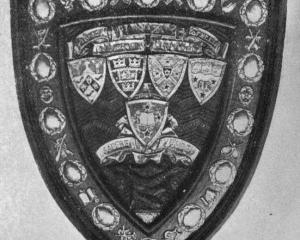A number of New Zealand woollen rugs were presented to Rear-admiral Matsumura, of the Japanese squadron, and his principal officers during their visit to Auckland.
Three of the rugs - a present from the Kaiapoi Woollen Company - were presented to the admiral, and six other officers were made the recipients of one each, the presentations being made by the Hon. G. W. Russell and the Hon. A. M. Myers, on behalf of the Government.
Framed copies of the armorial bearings of New Zealand were presented to the admiral and captains of the two visiting warships, and another framed copy was specially presented with the idea of its being retained on the Azuma as a souvenir of the visit to New Zealand.
Three sets of mounted views of New Zealand - the gift of the Hon. Dr McNab - were also presented to the admiral. Rear-admiral Matsumura expressed the thanks of himself and his officers for the gifts, which, he assured the donors, were very warmly appreciated.
•Dr J. L. Elmore, of Kansas City, U.S.A., has returned to Christchurch from an inspection of the ancient rock paintings at Weka Pass, North Canterbury, and he reports (says the Lyttelton Times) that they have puzzled him as deeply as they have puzzled other investigators.
He is impressed with their marked dissimilarity to the curved lines and scroll work which are the principal feature of the ancient arts of the Maoris, and he is inclined to favour the theory that they were done by a race different from the Maori - a race which probably came to New Zealand before the Maori immigrants.
Dr Elmore, who is making a special study of the arts of aboriginal people in different parts of the world, is simply collecting knowledge, and, by tracings and drawings, is preserving it for the use of other investigators.
He does not pretend to create theories or to analyse the facts he is accumulating, but he is very careful to make his records correct. He has taken tracings of the rock paintings at Weka Pass.
•Soldiers in smart blue uniforms are now to be seen at Hanmer Springs at any time of the day. They are the inmates of the Queen Mary Convalescent Home for returned soldiers, and the uniform is the new hospital costume which has been adopted by the New Zealand authorities.
The uniforms, which were issued only a few days ago, are extremely neat. They are a fairly dark blue in colour, with the ordinary brass military buttons, and in cut are very much like the usual khaki.
In every British military hospital the blue uniforms for inmates have been in vogue for many years, but they are usually very unsightly, and are made without any sense of proportion. The New Zealand article is, however, a different thing altogether, and looks just as smart as the khaki.
•A link connecting with the old days of bullock-teams has just been broken by the disposal of a fine team got together by Mr C. McLay, of Waikouaiti.
Mr McLay leased from the Borough Council the right to cut fencing material from the bush at the back of Mount Watkin; but a bush fire destroyed the best of the timber, and Mr McLay found it necessary to surrender his lease.
On Friday last Mr McLay trucked to the south six bullocks out of a fine team of 16 driven by his father (Mr John McLay) at the Palmerston jubilee.
Mr C. McLay's grandfather was the first to own a team of bullocks in Waikouaiti - in 1856 - making a period of 60 years during which the family has held to the pioneer system of carting.
- ODT, 21.7.1916.
COPIES OF PICTURE AVAILABLE FROM ODT FRONT OFFICE, LOWER STUART ST, OR WWW.OTAGOIMAGES.CO.NZ












